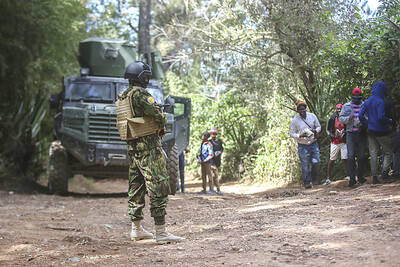North Korea secretly provided Libya with nearly two tonnes of uranium in early 2001, The New York Times reported on Saturday, citing unnamed US officials and European diplomats.
The International Atomic Energy Agency (IAEA) said there was 1.7 tonnes of uranium hexafluoride, a standard raw material for enrichment through feeding centrifuges, but experts told the newspaper the uranium was far short of the potency needed to make a nuclear weapon.
A large quantity of uranium hexafluoride was turned over to the US by the Libyans earlier this year as part of leader Muammar Qaddafi agreement to give up his nuclear program. At the time, the US identified Pakistan as the likely source.
However, the IAEA told The Times it found evidence that the uranium came from North Korea. The agency based its conclusion on interviews of members of the secret nuclear supplier network set up by Abdul Qadeer Khan, the former head of Pakistan's main nuclear laboratory.
American officials say the discovery of the North Korean connection is an intelligence success that resulted indirectly from Libya's decision to dismantle its nuclear program, and the ensuing drive to break up Khan's network, according to the newspaper's web site.
The uranium shipped to Libya could not be used as nuclear fuel unless it was enriched in centrifuges, which the Libyans were constructing as part of a US$100 million program to purchase equipment from the Khan network, The Times reported.
The paper said the classified evidence had touched off a race among the world's intelligence services to explore whether North Korea has made similar clandestine sales to other nations or perhaps even to terror groups seeking atomic weapons.

DITCH TACTICS: Kenyan officers were on their way to rescue Haitian police stuck in a ditch suspected to have been deliberately dug by Haitian gang members A Kenyan policeman deployed in Haiti has gone missing after violent gangs attacked a group of officers on a rescue mission, a UN-backed multinational security mission said in a statement yesterday. The Kenyan officers on Tuesday were on their way to rescue Haitian police stuck in a ditch “suspected to have been deliberately dug by gangs,” the statement said, adding that “specialized teams have been deployed” to search for the missing officer. Local media outlets in Haiti reported that the officer had been killed and videos of a lifeless man clothed in Kenyan uniform were shared on social media. Gang violence has left

US Vice President J.D. Vance on Friday accused Denmark of not having done enough to protect Greenland, when he visited the strategically placed and resource-rich Danish territory coveted by US President Donald Trump. Vance made his comment during a trip to the Pituffik Space Base in northwestern Greenland, a visit viewed by Copenhagen and Nuuk as a provocation. “Our message to Denmark is very simple: You have not done a good job by the people of Greenland,” Vance told a news conference. “You have under-invested in the people of Greenland, and you have under-invested in the security architecture of this

Japan unveiled a plan on Thursday to evacuate around 120,000 residents and tourists from its southern islets near Taiwan within six days in the event of an “emergency”. The plan was put together as “the security situation surrounding our nation grows severe” and with an “emergency” in mind, the government’s crisis management office said. Exactly what that emergency might be was left unspecified in the plan but it envisages the evacuation of around 120,000 people in five Japanese islets close to Taiwan. China claims Taiwan as part of its territory and has stepped up military pressure in recent years, including

UNREST: The authorities in Turkey arrested 13 Turkish journalists in five days, deported a BBC correspondent and on Thursday arrested a reporter from Sweden Waving flags and chanting slogans, many hundreds of thousands of anti-government demonstrators on Saturday rallied in Istanbul, Turkey, in defence of democracy after the arrest of Istanbul Mayor Ekrem Imamoglu which sparked Turkey’s worst street unrest in more than a decade. Under a cloudless blue sky, vast crowds gathered in Maltepe on the Asian side of Turkey’s biggest city on the eve of the Eid al-Fitr celebration which started yesterday, marking the end of Ramadan. Ozgur Ozel, chairman of the main opposition Republican People’s Party (CHP), which organized the rally, said there were 2.2 million people in the crowd, but